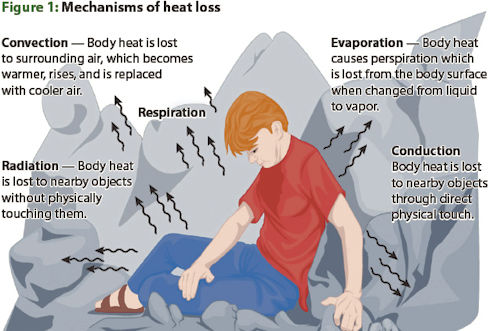Hypothermia is a condition which occurs when the core body temperature drops below the required temperature for normal metabolism and for proper body functions. Previously hypothermia mostly struck the homeless in cold environments however, with extreme sports becoming more popular hypothermia is now more prevalent throughout colder regions of the world. With proper and timely treatment, anyone with hypothermia should be able to survive.
Treatment
A special low temperature thermometer is used to detect hypothermia since regular ones do not measure accurately below 34.4Õ C. Hypothermia occurs when the body temperature falls below 35.0Õ C. By recognizing the symptoms of hypothermia and understanding the severity, a number of steps can be taken to improve the condition of the patient before taking them to the hospital.
If possible get the person indoors immediately. If not, then get them away from the cold of the ground by placing them on blankets or even leaves.
Remove any wet clothing and dry the person off before putting on fresh, preferably wind resistance clothing. If fresh clothing is not available use dry blankets or towels. Start with the head and torso first and then proceed to the limbs.
Try to get the person to move around but not enough to make them sweat. By sweating the body will cool down again making the condition worse.
Gently keep your arms around the person. Your own body heat will make them feel better.
Provide lots of warm drinks, chocolate and high energy foods. Do not give alcohol.
Apply direct heat if possible to the neck, armpit, and groin. Do not apply direct heat to the arms and legs.
Movement of a person with severe hypothermia must be gentle and slow. Abrupt movements may cause them to go into shock.
Keep them warm but avoid rubbing and massaging. This will worsen the condition.
Try to keep the person conscious, however if they do lose conscious monitor their breathing and pulse until the emergency team arrive. Only give CPR if there is no pulse.
Once a person with severe hypothermia reaches the hospital the doctors will attempt to raise the body temperature intravenously by pumping the body with warm fluids. In extreme cases, a procedure is done where blood is taken out of the body, warmed up and circulated back in.
Facts
The estimated mortality rate from hypothermia is approximately 38% to 75%.
If treated correctly, a person can recover fully from hypothermia if the body temperature is between 32.2° C and 35.6° C.
Even with treatment, when the body temperature is below 26.7° C recovery is rare and it is almost guaranteed that the victim will have medical complications.
Even though a person with hypothermia is not breathing and has no pulse, they can possibly be revived.
The lowest body temperature that a person has survived was a young girl in Sweden who recovered from a body temperature 13° C after a near drowning incident*.
Prevention
When going out for excursions in cold regions always remember that weather is extremely unpredictable. The first measure of prevention is to not expose yourself to temperatures that may cause hypothermia. If you are out and the weather takes a turn for the worse, turn around and find shelter. When preparing for the outing make sure to have extra clothing in case your clothes get wet. When dressing, have multiple layers and ensure that the outer layer is windproof. Make sure you cover your ears and head to prevent heat loss. Wool and synthetic fabrics are better to wear than cotton since they provide your body better insulation both when wet and dry. Before going out, avoid drinking and smoking as they both decrease the efficiency of your blood circulation.
Dangers
Though the greatest danger of hypothermia is death, there are a number of other symptoms that can cause the condition of the victim to worsen unnecessarily. One of the first and most dangerous effects of hypothermia is impaired judgment and confusion. This may even cause the person to believe they do not have hypothermia and are doing fine. As hypothermia progresses the ability to move and walk gets effected and in extreme cases becomes impossible. It is thus extremely important to get the person to safety before immobility hits. Drowsiness and shallow breathing followed by unconsciousness may also occur.
In approximately 20% to 50% of cases a condition called paradoxical undressing occurs where victims affected start removing their clothing causing a faster drop in body temperature. This occurs due to confusion, disorientation and possibly from certain muscles in the body which become exhausted and relax causing a sudden flow of blood and heat to the arms and feet making the person feel deceivingly warm.
